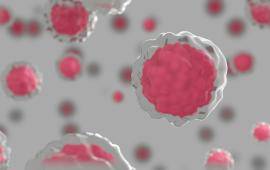
Lung Cancer natural treatment
Lung Cancer Integrative treatment is primarily focused to reduce the side effects of chemotherapy and radiotherapy.
During chemotherapy treatment, it is important to minimize side effects, so it is better tolerated and it is possible to complete the protocol cycles without interruption. It is necessary to control the immunity by leukocyte count test, since if the count is less than 3000, chemotherapy is postponed until it reaches these levels. On the other hand, the immune system is important in the control of cancer growth and once the chemotherapy cycles are finished it is necessary to recover the normal values of leukocytes in the shorter possible time.
There are of Chinese Herbs formulas that boost the immune system. Intravenous vitamin C also helps to strength the immune system. Side effects such as nausea, vomiting, fatigue can improve with Chinese Herb formulas to strengthen the digestive system in conjunction with acupuncture.
When Cisplatin is administered there is a risk of neurological toxicity that can affect the distal parts of the limbs more frequently (hands and feet). This side effect can be prevented or improved with acupuncture and specific Chinese Herb formulas.
Integrative oncology can also help alleviate the side effects of radiation therapy, such as radiodermatitis or fatigue. Also to reduce long-term effects by using antioxidant nutrients.
In cancer treatment it is very important to remove the cancer stem cells, so surgery is the treatment with the best prognosis. Chemotherapy and radiotherapy are also aimed at killing cancer cells, but they cause significant side effects and weaken the body. Therefore, recovering and strengthening the body after these treatments, helps to prevent cancer recurrences.
There are scientific studies on the anticancer effect of some Chinese Herbs in lung cancer, such as Scutellaria baicalensis and Trichosanthes kirilowii.
There are also scientific studies on the use of orthomolecular medicine (vitamins and minerals) in lung cancer that can help increase the survival and quality of life of these patients.
PH's control focused to reduce acidity levels in the body and proper diet help to better recovery and to control cancer growth.
Lung Cancer: Types 
Small cell or microcytic carcinomas: represents 20% of all tumors. It is preferentially located in the central area of the lungs. It is characterized by rapid growth.
Non-small cell carcinomas: represent the remaining 80% of lung cancers.
The most common types are:
- Squamous or squamous cell carcinoma: It is the most common type of bronchopulmonary cancer in our country, representing 40% of non-small cell carcinomas. It is usually located in the central part of the lungs, and frequently becomes necrotic inside and resembles an abscess. It has relatively slow growth.
- Adenocarcinoma: Represents 30% of non-small cell carcinomas. It is the least related to tobacco consumption. It is produced in the cells of the mucous glands. It is more common in women and is located in more peripheral areas of the lungs, which is why it frequently affects the pleura and chest wall. Compared to other types of lung cancer, it usually grows more slowly. Additionally, it is more likely to be found before it spreads outside the lung. In recent years, this histological variant has gained special interest when it was discovered that a subgroup of patients have a molecular alteration (EGFR mutation) that allows these patients to be treated with therapeutically targeted drugs.
- Large cell carcinoma: It is named for the size of the cells that make it up. It is the least common type of bronchopulmonary carcinomas, representing 10% of them.
Lung Cancer: Stages 
In order to make a judgment about the patient's prognosis and determine the most appropriate treatment, it is important to determine what phase the patient is in. The system most frequently used for classification is the TNM. These acronyms refer to three aspects of cancer: T refers to the size and location of the tumor, N to the involvement of lymph nodes, and M to whether or not other organs are affected.
Primary tumor (T):
T0: There are no signs of a primary tumor.
TX: occult cancer, demonstrated in bronchial lavage cytology but not radiologically or in fiberoptic bronchoscopy. Bronchopulmonary secretions contain malignant cells but there is no other evidence of the existence of lung cancer.
TIS: carcinoma in situ.
T1: tumor less than or equal to 3 cm in maximum dimension, surrounded by lung tissue or visceral pleura and without proximal invasion of the lobar bronchus on fiberoptic bronchoscopy.
T2: tumor greater than 3 centimeters in greatest dimension; or tumor of any size invading the visceral pleura or with atelectasis (lung collapse) or obstructive pneumonitis extending to the hilar region. On bronchoscopy, the proximal extension of the tumor may be limited to the lobar bronchus or be at least 2 cm from the carina. Atelectasis or obstructive pneumonitis should not affect an entire lung.
T3: tumor of any size with direct extension to the costal wall (including tumors of the superior fissure), diaphragm, mediastinal pleura or pericardium; without involvement of the heart, great vessels, trachea, esophagus, vertebral bodies; or a tumor of the main bronchus less than 2 cm from the carina, without its infiltration. Atelectasis affects an entire lung. There is non-malignant pleural effusion.
T4: tumor of any size with infiltration of the mediastinum or heart, great vessels, trachea, esophagus, vertebral bodies or carina; or with malignant pleural effusion. Pleural effusions that are neither bloody nor exudative and have multiple negative cytologic studies are not classified as malignant for staging purposes.
Regional lymph nodes (N):
N0: no demonstrable lymph node metastases.
N1: metastasis to the peribronchial or ipsilateral hilar lymph nodes or both, including direct extension of the tumor.
N2: metastases in the ipsilateral mediastinal or subcarinal lymph nodes. N3: metastases in the nodes: mediastinal or contralateral hilar, scalene ipsi or contralateral, or supraclavicular.
Distant metastases (M): M0: no known distant metastases.
M1: distant metastases present, specifying their location, for example in the brain. Based on these aspects, non-small cell lung cancers are grouped into the following stages or stages:
Lung Cancer: Conventional treatment 
Surgical treatment
Surgery is the first and most effective treatment option for non-small cell cancers in localized stages.
In small cell carcinomas, the first treatment option is chemotherapy.
The type of surgery will depend on the size, location and extension of the tumor. When a lung lobe is removed (each of the parts into which the lung is divided) it is called lobectomy, when what is removed is an entire lung we speak of pneumonectomy.
Treatment with radiotherapy
In lung cancer, the use of radiotherapy varies depending on the type of cancer: In non-small cell lung cancers, radiotherapy is used when it is impossible to perform surgery due to the risk it poses to the patient, when the tumor is inoperable or as treatment for some metastases. It can be combined with chemotherapy. In small cell carcinomas, radiotherapy is used as a complementary treatment to chemotherapy in cases where the disease is localized. It is also indicated in the treatment of brain metastases.
Treatment with chemotherapy
Non-small cell lung cancer
Adjuvant treatment (after surgery) Patients with non-small cell lung carcinoma undergoing complete resection, however, have a high risk of recurrence (50% in stage IB, 70% in stage II and a percentage even higher in patients with stage IIIB tumors). This is why the use of adjuvant chemotherapy (after surgery) has been studied for several decades. The first studies, which were carried out in the 70s and 80s of the 20th century, identified platinum derivatives as active agents for the treatment of this type of cancer. In recent years, several clinical trials have been carried out to explore the effectiveness and optimal administration of polychemotherapy regimens (based on combinations with platinum salts). The most important studies published recently (IALT, BIG, ALPI, ANITA and JBR10) explored different combinations of cisplatin (mainly with vinorelbine) and found a benefit in terms of overall survival and progression-free survival. This is why the possibility of receiving adjuvant chemotherapy is offered to patients undergoing surgery for stage II or III lung cancer.
Treatment of locally advanced disease: The treatment of locally advanced non-small cell carcinoma of the lung is a field of active research at the present time. Generally, patients in stage IIIA according to the pathological staging classification usually undergo surgery and subsequently treated with adjuvant chemotherapy. Patients with pleural or pericardial tumor effusion are usually offered palliative chemotherapy since, although these cases are currently classified as IIIB, the prognosis and evolution of these patients is similar to that of those with extrathoracic disease. In fact, in the proposed revision of the TNM classification, these tumors are considered stage IV. For the remaining patients with stage III tumors, treatment varies between the administration of neoadjuvant chemo-radiotherapy, followed by surgical resection and a variable number of cycles of consolidation chemotherapy, or the use of concomitant chemoradiotherapy (i.e., given together). ).
Treatment of advanced disease: The value of chemotherapy treatment for patients with metastatic non-small cell carcinoma of the lung was highlighted by studies comparing treatment with cisplatin-based chemotherapy and supportive treatment versus to supportive treatment without chemotherapy. A statistically significant difference in overall survival was observed in favor of chemotherapy treatment. There are multiple active agents in the treatment of NSCLC, which have been used both in combination and as monotherapy. The most commonly used are platinum derivatives (cisplatin and carboplatin), taxanes (paclitaxel and docetaxel), vinorelbine, gemcitabine, etoposide and pemetrexed. In recent years there have been very significant advances in the treatment of lung cancer, incorporating new drugs directed at specific targets of tumor cells. This is the case of drugs directed at EGFR (epidermal growth factor receptor) or VEGF (vascular endothelium-derived growth factor)
Small cell lung cancer
The treatment of small cell lung cancer consists of the administration of chemotherapy based on a combination of a platinum (cisplatin or carboplatin) with etoposide. The rad
Ask for opinion and find an appropriate solution to your problem
ONLINE Doctor Consultation






